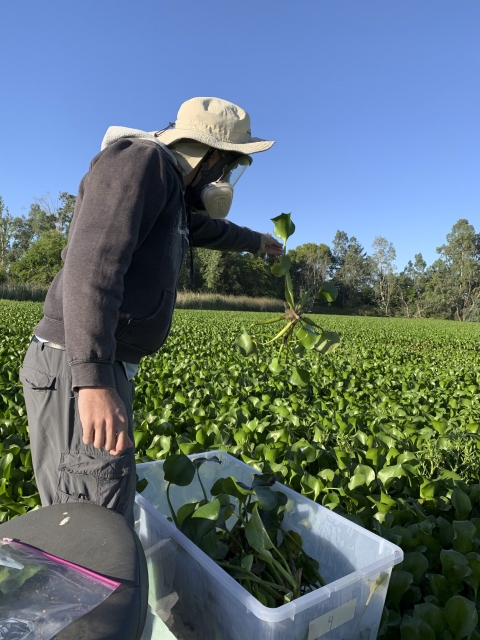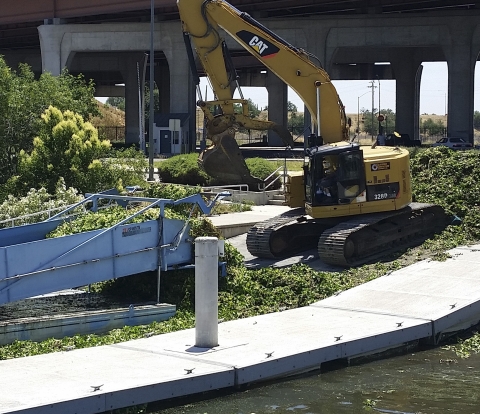Looking at the water hyacinth’s lovely lavender flowers and lush green leaves, it’s easy to see why it was brought here from South America. But too much of a good thing can cause trouble, and few things turn into “too much” as quickly as water hyacinths (Eichhornia crassipes).
Hyacinth plants float on water, where they interlock into dense, sturdy mats. One of the world’s fastest-growing plants, the hyacinth’s mats can double the area they cover in just two weeks.
“I’ve seen them cover the entirety of a creek in one season,” said U.S. Fish and Wildlife Service biologist Leanna Zweig of the San Francisco Bay-Delta Fish and Wildlife Office. “There was no water surface showing; it looked like you could walk across it.”
Over time, hyacinth mats in other countries actually have grown thick enough to walk across, and some resourceful farmers have even grown crops on them. If left to grow unrestrained here, the plant would likely cover the interior channels of the Sacramento-San Joaquin River Delta completely.
“The waterways would be filled in, blocking access for boating traffic and water recreation, and eliminating habitat for native fishes,” Zweig said, noting the Delta is home to sensitive species like the endangered Delta smelt and winter-run Chinook salmon.
Blocking sunlight and “acting like plastic wrap over the water,” hyacinths put native plants and animals at risk by preventing photosynthesis and reducing water-oxygen levels. They also clog irrigation pipes and obstruct waterways, affecting recreational boaters and commercial shipping.
California State Parks Division of Boating and Waterways manages an integrated pest control program that uses several methods to control hyacinth growth, including herbicides, mechanical harvesting, and insects implemented by the U.S. Department of Agriculture’s Agricultural Research Service. But the hyacinth is so well-established, it can’t be eliminated completely.
“For the new invasive plants that are popping up, if DBW gets to them early enough, they can control them,” Zweig said. “That’s why they do regular surveillance for new invasive plants, so they don’t get a foothold in the Delta.”
The Division of Boating and Waterways asks that you call 888-326-2822 or email ais@parks.ca.gov if you spot water hyacinth or the state’s other invasive floating plants, the South American spongeplant (Limnobium laevigatum) and Uruguay water primrose (Ludwigia hexapetala). For more information, visit DBW’s website, dbw.parks.ca.gov, and click the “Environment” link at the top of the page.
You can help prevent the spread by choosing native plants for your pond or water garden, and never discarding invasive plants in a natural waterway or habitat. Boats and other gear should also be cleaned when leaving a waterway, as seeds and plants can be transported in dirt and small spaces.
“Invasive aquatic plants will slowly fill in our waterways if they’re left unchecked,” Zweig said. “If we want the channels for flood capacity, water transport and recreation, and for fish to be safe, we need to control the growth.”





